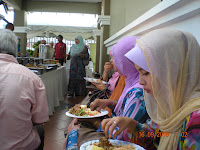From Woodlands train terminus, take the bus to the nearest MRT station. Ask the officers there for assistance for how to get to Bugis MRT. Take the MRT to Bugis MRT and get off at Bugis MRT. Walk through the Raffles Hospital lobby and exit at the front entrance. Continue walking to Arab St-North Bridge Road junction. The Sultan Mosque is a big mosque but the main entrance is to the left. Cross the street and go round the mosque periphery to the main entrance, which is actually the rear of the mosque (the front is the Qiblat). Enter the mosque ground via Gate 4 (near toilets) or Gate 5 (near shops). The red paved brick street is Bussorah Street.
Ladies prayer space:
The ladies prayer space in on the second floor (go in through the main entrance of the mosque and take the stairs at both sides). Slippers can go on the shoe rack outside the mosque, before the steps.
Friday prayer:
The men pray in the large main prayer hall where the mimbar and mihrab are (that is the direction of Qiblat or front of the mosque). The mosque is packed on Friday. It is better for women to wait till the men have completed Friday prayer before entering the mosque to pray.
 |
| Masjid Sultan, main entrance at rear, fronting Bussorah St. Masjid Sultan in Facebook |
 |
| Syed Habib lecturing. Photo from Picasa album of Masjid Abdul Aleem Siddique. |
 |
| Same as above |
 |
| Different view of the same chandelier. |
 |
| Front lawn and nursery |
 |
| Entrance to Makam is closed off |
 |
| Masjid Abdul Gaffoor |
 |
| Second generation Ahmad Mohamed Salleh Angullia in The Who's Who in Singapore 1963. (Article was obtained from USM library in Penang.) |
 |
| Masjid Angullia (from Google Maps). |
Masjid Abdul Aleem Siddique
 |
| Abdul Aleem Siddique |
 |
| Abdul Aleem Siddique |
 |
| Footprints on the Journey of Human Fellowship, written by Zainudin Mohd Ismail, Jamiyah Singapore. Download from: http://www.jamiyah.org.sg/Arabic/sharing%20file/footprint.pdf
Untitled
His Holiness Hazrath Maulana Shah Mohamed Abdul Aleem Saheb Siddiqui Al'quadri, etc., the well-known qualified theologian of Meerut City, India, addressed a large gathering at the Aljunied Islamic School, Victoria Street, last Sunday on the subject "How to understand the Holy Quran." Among those present were Mr Soon Kim, Syed Abdul Rahman Aljunied, Mr A.M.S. Angullia, Haji Manjoor Saheb, and many other prominent Mohammedans. Dr H.S. Moonshi also addressed the gathering.
|
 |
| Masjid Abdul Aleem Siddique (from Google Maps). |
Interior of dome and spacious prayer hall
 |
| Qiblat, mihrab and front of mosque interior |
 |
| Al-Asma al-Husna calligraphy all over on the walls. Syahadah calligraphy inside the mihrab. Even the mimbar/lecturn has Islamic geometric designs and objects. |
 |
| Beautiful al-Asma al-Husna calligraphic relief on the back wall |
 |
| Spacious prayer hall |
Masjid Kassim
Masjid Ba'alawie
Can be found using Google maps. It is a small old mosque. Tan Sri Prof Ahmad Ibrahim used to come here. The Arabic Al-Attas (Alattas) family used this mosque. The Al-Attas families can be found in Indonesia, Singapore and Malaysia.
Masjid Chander Road
http://pictures.nl.sg/SearchByTag.aspx?tag=Chander%20Road
The location can be found using Google maps - it points to an empty plot, just grassland with a blue zinc fence. This is an old mosque and has been pulled down. A 1984 photo can be found here:
http://pictures.nl.sg/2d8cc929-8e95-4dcd-9bfc-754ea116bdf5.aspx
Among the jemaah here were Ismail Ballah, Dr Mohamed Ibrahim bin Ismail and Tan Sri Prof Ahmad Ibrahim. When the newspapers published Ismail Ballah's demise, it could have pointed to the Muslim community here. "Arab" was used to refer to the Indian Muslims. Today, the Indian Muslims are grouped as Malay. The Chander Road mosque was within Little India.
 |
| Street scene in Little India |
http://www.hjmuhdsalleh.org.sg/Templates/1.html
Nearby is Makam Habib Noh which has an interesting history. The descendants of Habib Noh can be found in Penang and elsewhere. Habib Noh's close friend was Haji Muhammad Salleh @ Nakhoda Nan Intan, whose grave lies at the graveyard adjoining Masjid Batu Uban in Penang. Batu Uban was the first Malay settlement in Penang before Captain Francis Light arrived on the island.
Other mosques:
http://en.wikipedia.org/wiki/List_of_mosques_in_Singapore



























